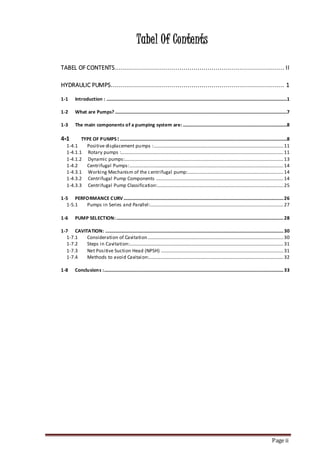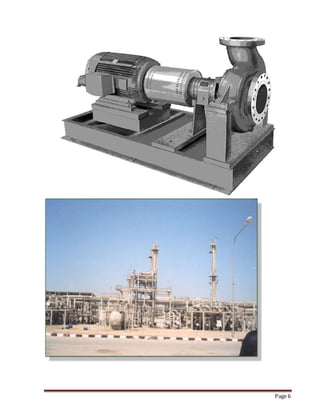The document discusses hydraulic pumps. It begins by introducing pumps and their importance in applications like water supply, drainage, sewage, irrigation, chemical and petroleum industries, and medicine. Pumps are defined as devices that expend energy to raise, transport, or compress liquids. The document then discusses the history of pumps dating back thousands of years, including early devices like the Noria water wheel and Archimedes' screw. It provides examples of how pump technology has evolved and expanded its applications over time.


































![Page 32
The net positive suction head (NPSH) is the absolute pressure in excess of the
liquid vapor pressurethat is available at the pump suction nozzle to move the liquid
into the eye of the impeller.
The difference between NPSHa and NPSHr is less than 0.3 ∼ 1.0m at the time
of checking vendor data sheet [ that is, NPSHa¬ NPSHr〈 (0.3 ∼ 1m)], decision
on NPSH test shall be made according to Engineering Specification SES-GA-201E
and API 610.
Pumps where difference between NPSHA and NPSHR is less than 0.6 meter
are not acceptable.
The diameter of the pump suction port is usually bigger than the discharge or
exit diameter in order to minimize the kinetic energy head entering the pump,
because this kinetic energy decreases the maximum suction lift and enhances
cavitation
NPSH can be defined as two parts:
1- NPSH Available (NPSHA): The absolute pressure at the suction port
of the pump.
2- NPSH Required (NPSHR): The minimum pressure required at the
suction port of the pump to keep the pump from cavitation.
NPSHA is a function of your system and must be calculated, whereas NPSHR
is a function of the pump and must be provided by the pump manufacturer. NPSHA
must be greater than NPSHR for the pump system to operate without cavitation. Put
another way, you must have more suction side pressure available than the pump
requires.
1-7.4 Methods to avoid Cavitaion:
NPSHa (P(suction) - P(saturation) >= NPSHr Increase NPSHa by
1- Increase pressure at suction of pump
2- Decrease liquid temperature
3- Reduce head losses](https://image.slidesharecdn.com/hydraulicpumpscompelete-150313171250-conversion-gate01/85/Hydraulic-pumps-compelete-35-320.jpg)
